Get ready to explore 25 California caves you can visit—lava tubes, sea caves, marble caverns, and more. Whether you’re hiking through the Gold Country or paddling the coast, our curated guide helps you find self-guided as well as tour-required caves across Northern and Southern California
Whether you walk, climb, crawl, or kayak, you will want to check all these California caves off your list.
Awesome Caves in California You Can Explore
Northern California Caves
Explore lava tubes and marble caves surrounded by forest and mountains in the northern part of the state.
Lake Shasta Caverns (National Natural Landmark)

What makes it unique: These are among California’s best show caves, accessible by a scenic catamaran and mountain bus ride.
Lake Shasta Caverns have been drawing in folks as they road trip along Interstate 5 for generations.
Shasta Lake was formed in 1945 when the Shasta Dam was completed, flooding the area below the carverns.
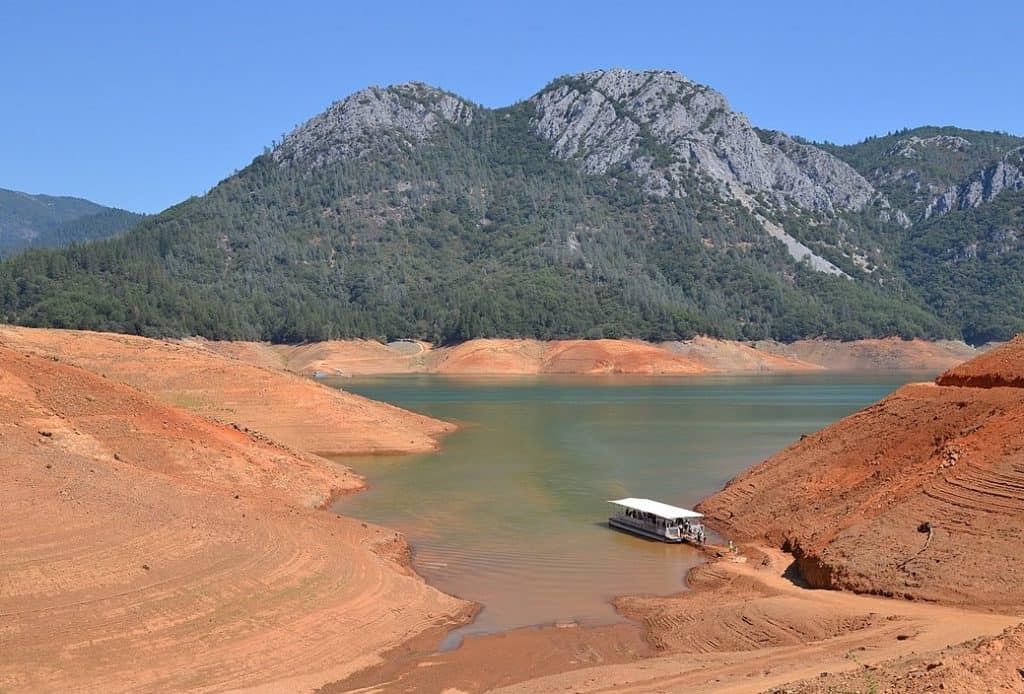
Visiting tips:
- Tours only: Daily guided tours (45–60 minutes) highlight dramatic limestone formations like stalactites, stalagmites, and soda straws
- Scenic approach: Catamaran across Shasta Lake, then a short mountain bus ride
- Cave conditions: Always 58°F with 90% humidity — bring a jacket!
The paths inside the cave are as wide a regular hallway, so you won’t have to do any crawling or navigate tight squeezes. You will, however, have to navigate some stairs during the tour.
Fun fact: The Wintu Tribe used the cave for centuries. It was officially “discovered” in 1878 — decades before the lake existed. They were officially “discovered” by an employee of a fish hatchery along the McCloud River.
Subway Cave
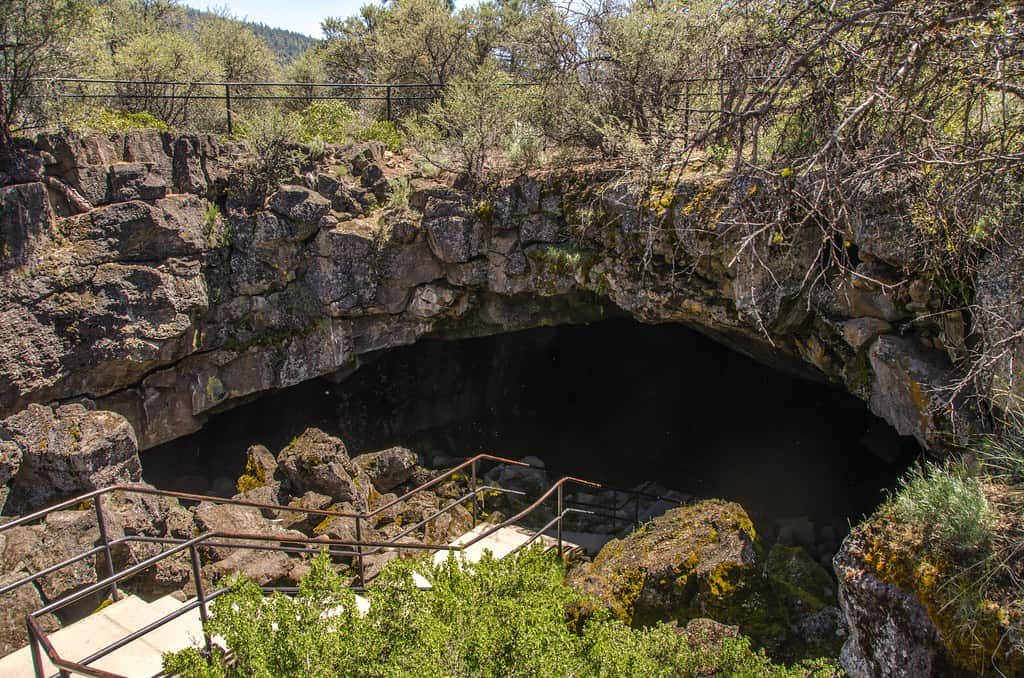
What makes it unique: It is one of the most accessible lava tubes in California, ideal for beginners.
Visiting tips:
- Self-guided and free to explore from April–October
- Located in Lassen National Forest, 15 miles north of Lassen Volcanic National Park
- Cave gear: Bring a flashlight and wear sturdy shoes — lava rock can be jagged
- Chilly inside: The interior holds steady at 46°F
- Trail: Short 1/3-mile walk with interpretive signage
Fun fact: This lava tube was created 20,000 years ago by molten lava draining beneath hardened surface flow.
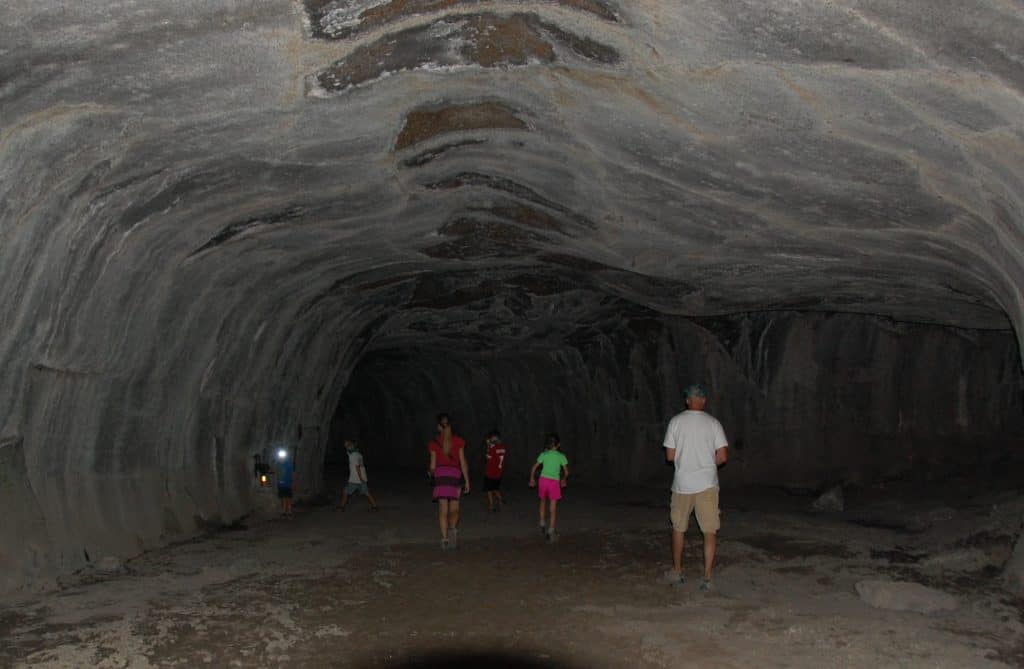
We love Subway Cave because it is self guided but not too difficult to explore. There are some informational plaques to read along you 1/3-mile journey inside the lava tube which will provide a good lesson in geology and the region’s rich volcanic history.
Lava Beds National Monument
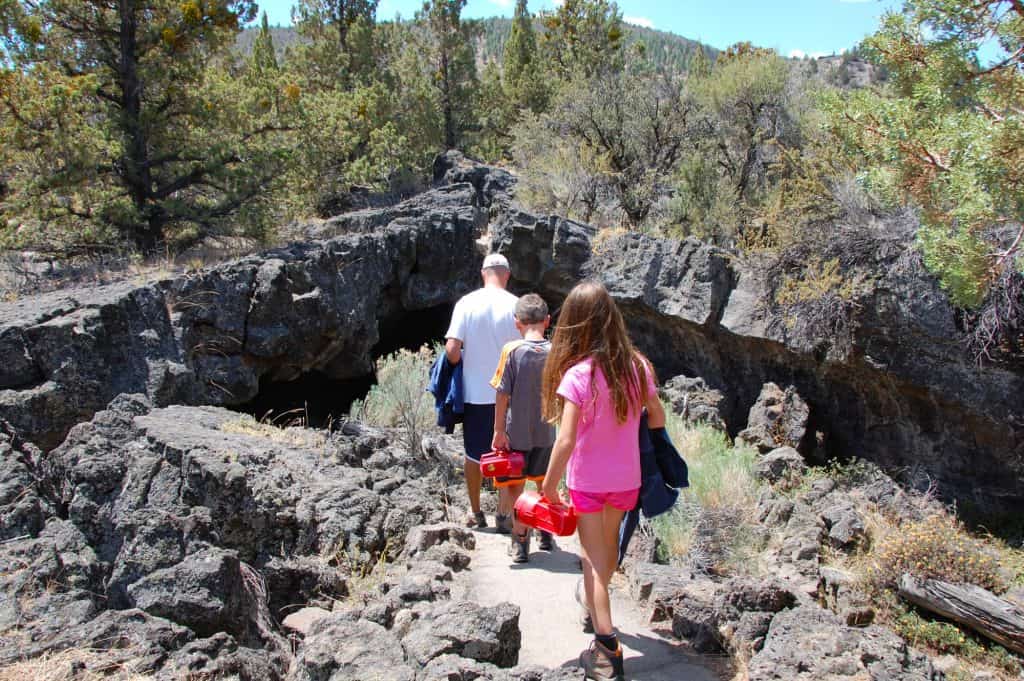
What makes it unique: This park is home to over 800 lava tube caves — the largest concentration in North America.
If I were to pick a top caving destination in California, it would be Lava Beds National Monument in far northeastern California. Keep in mind that there are no services (pack your own food and water) within the park. There is one campground within the park but no lodging.
Visiting tips:
- Remote location: Near Klamath Falls at the Oregon border, prepare for limited services
- Start at the Visitor Center: Gear rentals (flashlights, helmets), cave maps, and safety guidance available
- Cave gear: Closed-toe shoes, long sleeves, flashlights, and hard hats recommended
- Bat safety: You’ll need a cave clearance sticker to prevent spread of White-nose syndrome
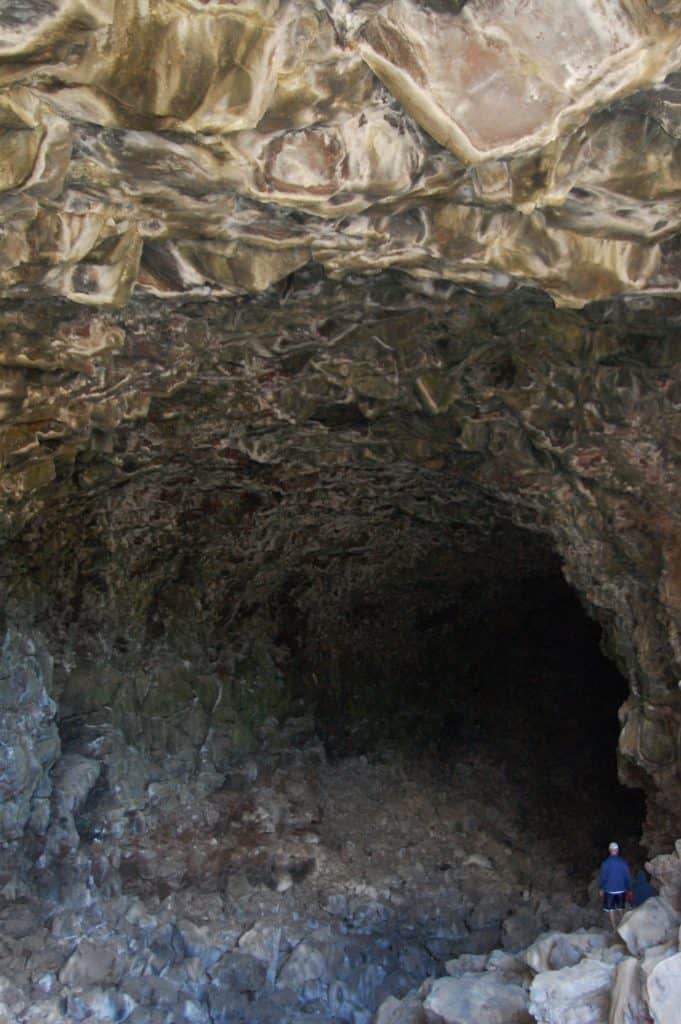
There is no doubt that this a volcanic landscape. In some ways the landscape reminds me a bit of the scenery on the dry side of Hawaii’s Big Island. Lava rock and scrub brush dominate the scene. The weather outside can be quite warm in the summer months with very little shade, but luckily it is cool inside the caves.
There are lots of caves to explore but the ones listed below are among the most popular. Even on a busy day you will likely have some of these caves all to yourself. Grab a map at the visitor center so you know where to find them. You can also print one out ahead of time.
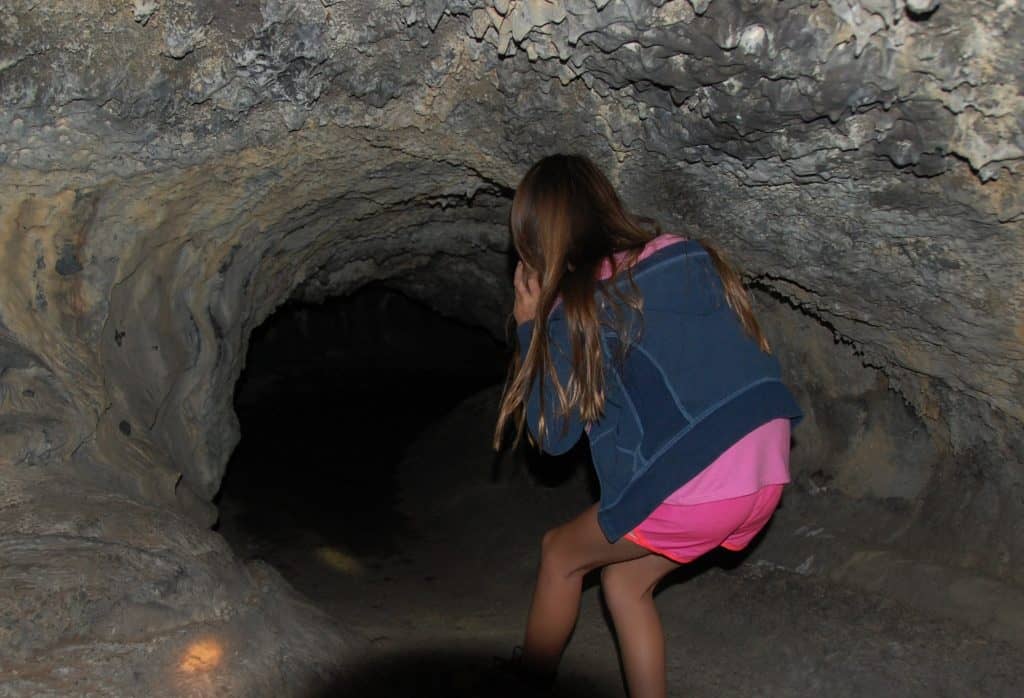
Top caves to explore:
- Golden Dome: Features unique bacterial sheen on the ceiling
- Mushpot Cave: Paved, lighted, and educational — perfect for beginners
- Skull Cave: Wide, short cave with an underground ice floor
- Valentine Cave: 1,635 feet long with optional crawling
- Sunshine Cave: Natural skylights illuminate the cave floor and plants grow inside
- Golden Dome Cave: Enter and exit this 2,229-foot-long cave via a ladder and enjoy the gold bacterial sheen on the ceiling
- Hopkins Chocolate Cave: Navigate three-foot ceilings and disover arches formed by cave collapses
Tip: If you visit on Saturdays in the winter, try to snag one of the six tickets to enjoy a ranger-led tour of Crystal Ice Cave which has large ice stalactites and stalagmites, and even ice waterfalls!
Pluto’s Cave
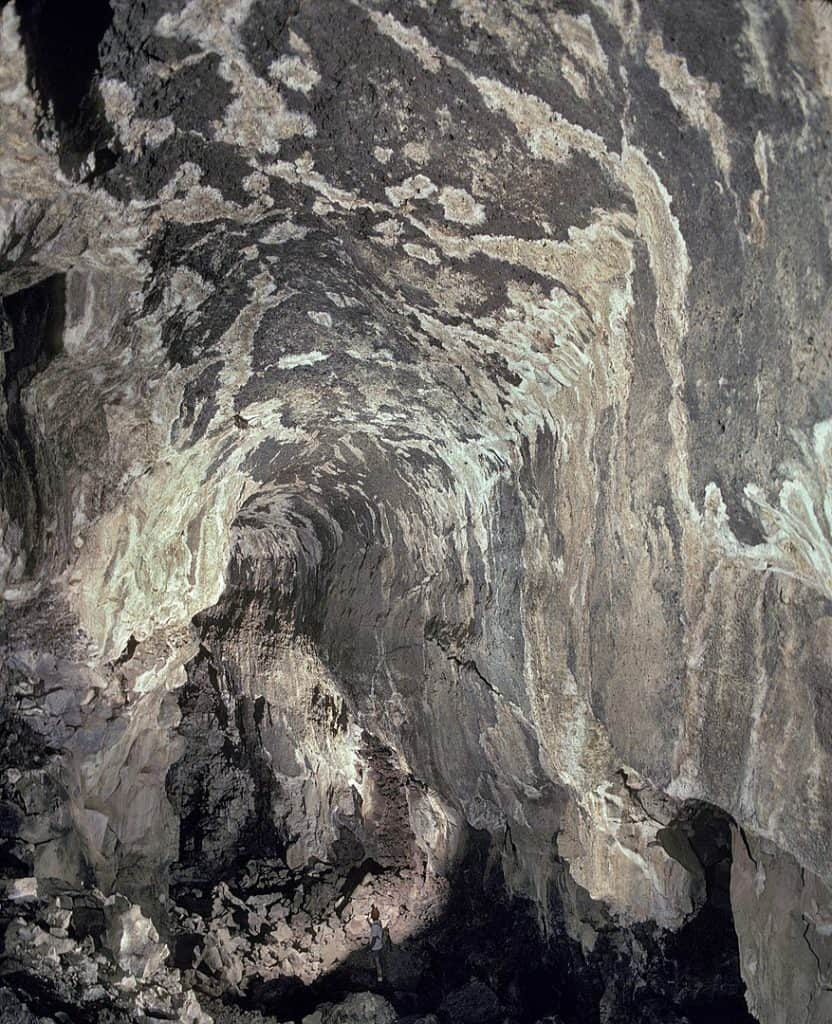
What makes it unique: A little-known lava tube near Mt. Shasta, perfect for rugged explorers.
Visiting tips:
- Located near Weed, CA in Klamath National Forest
- Roughly 1,200 feet of cave to explore; partially collapsed
- Bring a flashlight and wear long pants — conditions are dusty with bats and rodents
- Not maintained — expect natural, raw cave experience
Plutos Cave is a cave that goes a bit under the radar thanks to its remote location. It was discovered by a rancher in 1863 who was looking for some stray cattle.
Expect to get dusty and dirty when scrambling inside the cave, this is the real deal and not maintained. Long pants, long sleeves, and even gloves are recommended.
Here is a link with more details about Pluto’s Cave as well as directions.
Central California Caverns
Black Chasm Cavern (National Natural Landmark)
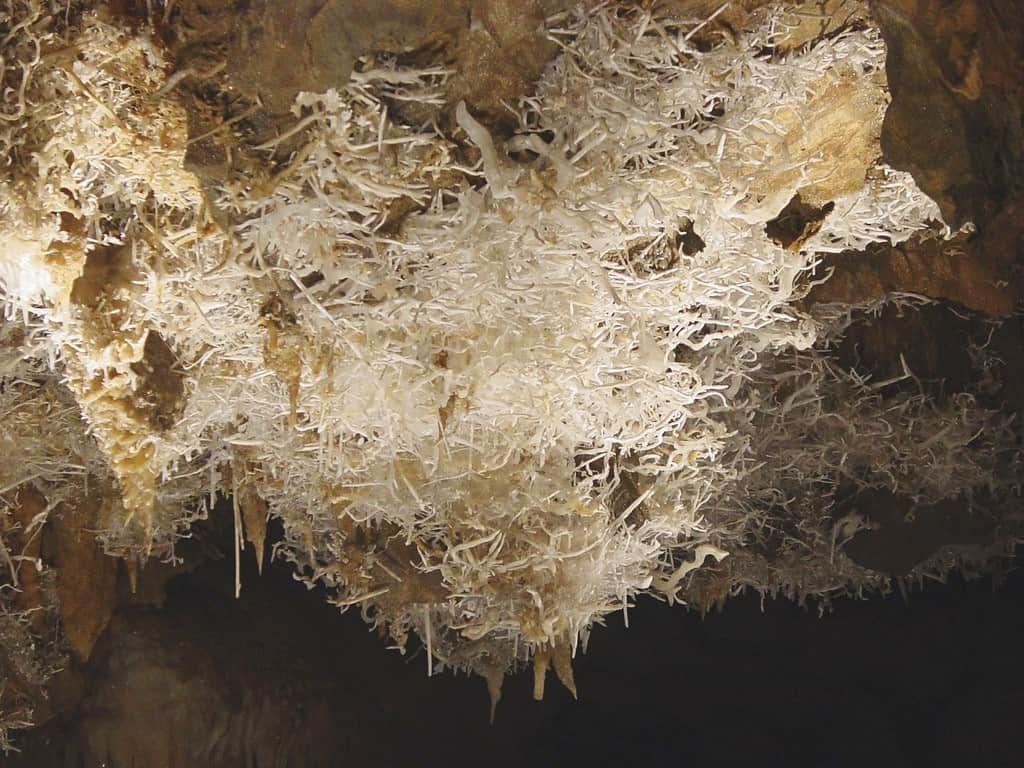
What makes it unique: Renowned for its rare helictite formations — delicate, spiraling crystals found in few caves worldwide.
There are a few different caves in California’s Gold Country that are fun to visit. The first one is Black Chasm Cavern National Natural Landmark in tiny Volcano, California.
This cave gained its “National Natural Landmark” status from the National Park Service due, in part, to its large display of rare helictite formations formed by hydrostatic pressure. Hydrostatic pressure is caused by water pushing crystallized minerals through porous cavern walls.
Visiting tips:
- Location: Volcano, CA in Amador County
- Tour only: 50-minute guided walking tour through three chambers
- Moderate exertion: Involves five flights of stairs
- Check out the beautiful blue lake in the 2nd chamber.
- Cave climate: 58°F year-round — bring a sweatshirt
Fun fact: While the cave had been used by Miwok Indians for many years, it was “discovered” and explored during the California Gold Rush in 1854. It was open to public guided tours in the 1990s.
California Cavern (State Historic Landmark)
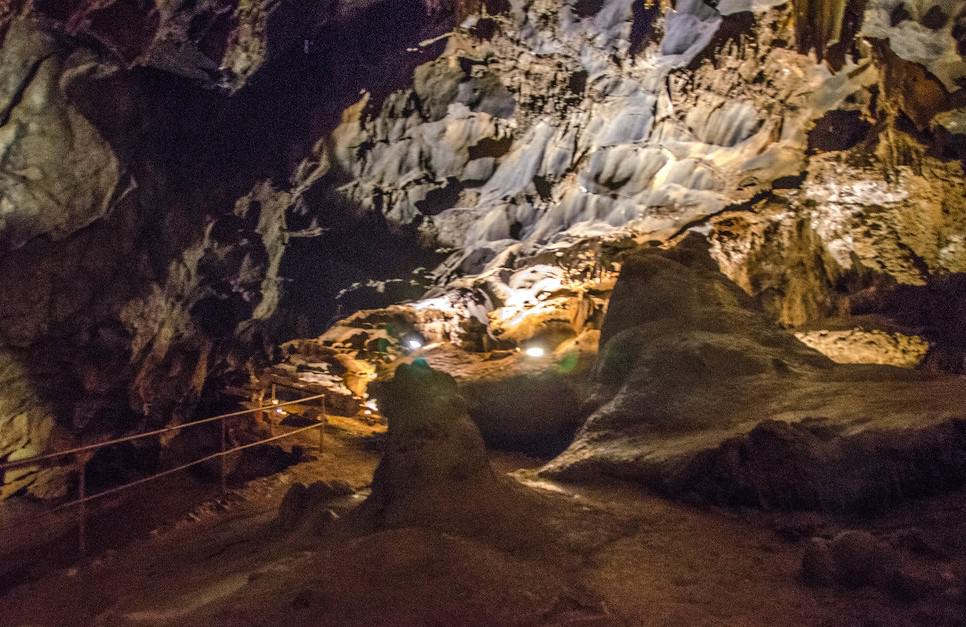
What makes it unique: The first public show cave in California, with wild cave expeditions available for adventurous explorers
Visiting tips:
- Location: Calaveras County, near Murphys
- Tour options: From easy walking tours (45–80 min) to crawling/clay-filled Middle Earth Expeditions
- Historic appeal: Visited by John Muir and Mark Twain in the 1800s
- Bring gear: For adventure tours, you’ll need a change of clothes — they get muddy!
Fun Fact: The cavern is said to have been used by as a jail by the local Miwok Indian Tribe.
California Cavern was originally called “Mammoth Cave”, piggybacking off the fame of the Mammoth Cave system in Kentucky, said to be the largest in the world.
There is still a Mammoth Cave Expedition tour you can take inside this cave system which explores the historic “Mammoth Cave” area and “Jungle Room”. This is a great option for those who want to do more adventurous things, like crawling and squeezing through tighter passages.
Want even more adventure? Check out the Middle Earth Cave Expedition. This includes the Mammoth Cave areas as well as the Middle Earth are which was discovered in 1980. You will get dirty as you make your way through knee deep cave clay. You will also get to go rafting across Tom’s Lake. This tour ends with a well-earned shower.
Mercer Caverns
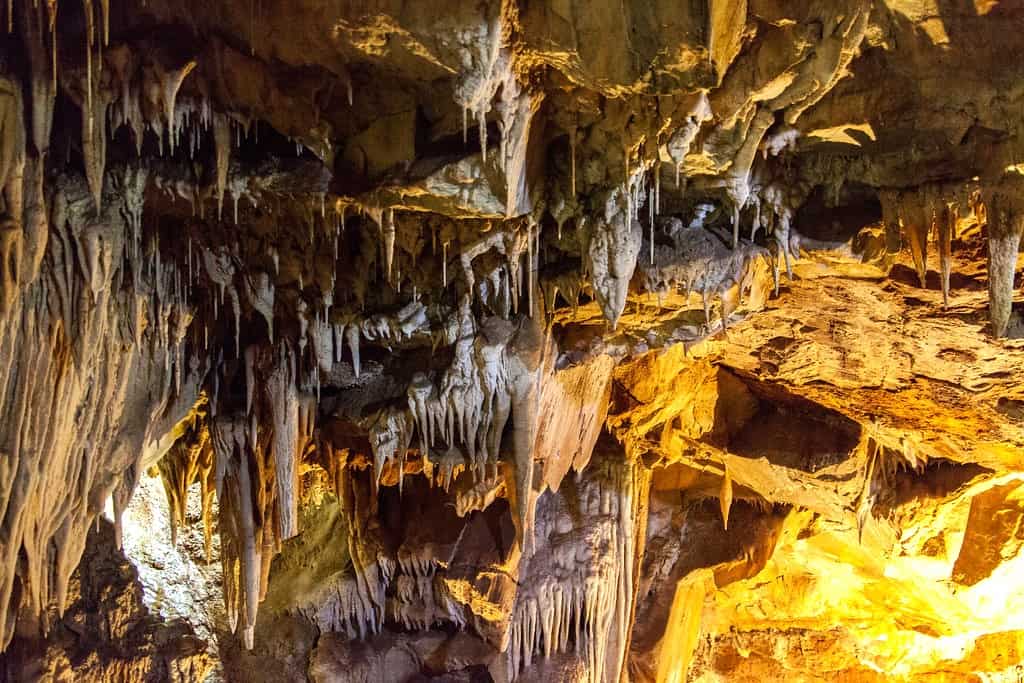
What makes it unique: Famous for its argonite crystals and early skeletal discoveries.
Visiting tips:
- Location: Near Murphys, CA
- Tour length: 45 minutes with 440 stairs round trip (16 stories)
- Cave climate: Steady 55°F — dress accordingly
- No crawling, but you may need to stoop or squeeze through narrow sections
Fun fact: The skeletal remains of six different people have been found inside the cavern– four adults, one child, and one infant. Remains of an extinct Sierra gound sloth and a giant anteater have been found here as well.
Mercer Caverns was discovered in 1885 by its namesake, Walter J. Mercer. Some things have changed since then as there is now electric lighting and clear pathways.
The 45-minute tour of the cave involves 208 stairs down into the cavern and 232 back up. In all, you will be climbing what is equivalent to a 16-story building.
Sea Caves at Van Damme State Park
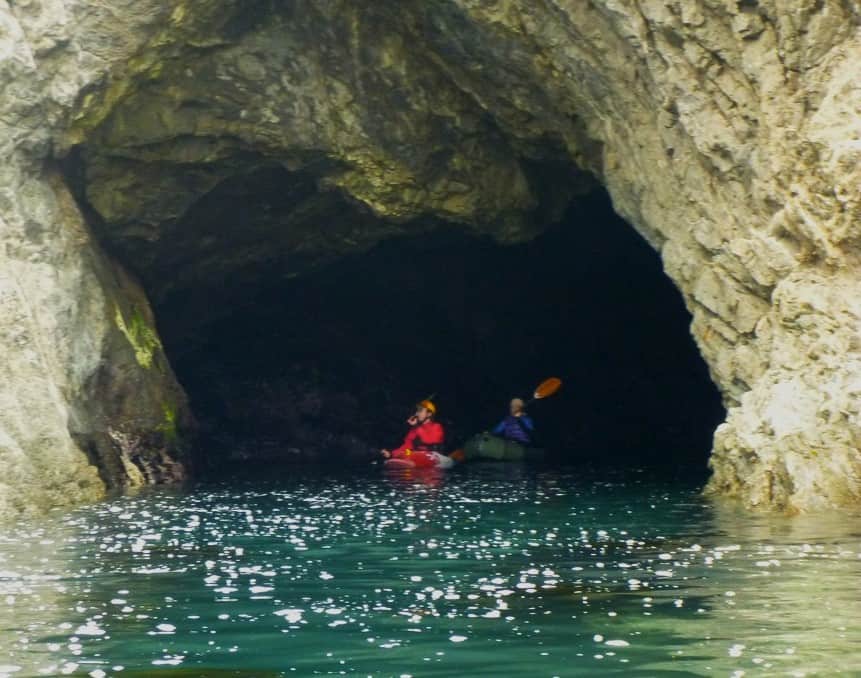
What makes it unique: A rare chance to paddle into sea caves surrounded by Mendocino’s dramatic coastal cliffs.
Not all caves in Northern California are underground; some are in the ocean! The Van Damme sea caves in Mendocino County are best explored via a kayak tour, and Kayak Mendocino is happy to lead your paddling expedition.
Visiting tips:
- Guided kayak tours only: Kayak Mendocino offers 90-minute “Sea Cave Nature Tours” daily, suitable for ages 6+. All gear is provided.
- Wildlife sightings: Expect to see harbor seals, sea stars, mussels, and birds like cormorants and oyster catchers.
- Location: Launch from Van Damme Beach in the town of Little River, three miles south of Mendocino.
- Conditions: Tours are timed with the tides for safe entry into the caves. Morning tours often have calmer conditions.
- Bring layers: Even in summer, fog and wind are common along the coast.
The sea caves are located in the waters off Van Damme State Park in the small Mendocino County hamlet of Little River. The park is known for its beaches, redwoods trees, pygmy forest, and day hiking.
Fun fact: The sea caves formed as waves relentlessly pounded and eroded the sandstone bluffs over thousands of years.
Caves in Central California
Pinnacles National Park Caves
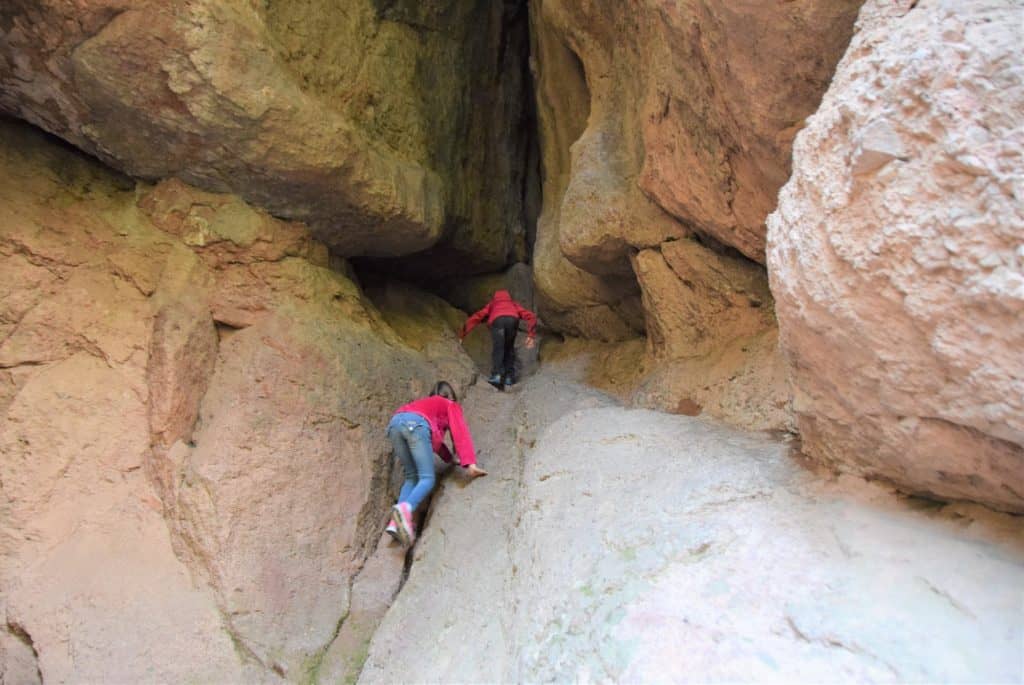
What makes it unique: Home to California’s most dramatic talus caves—formed by massive boulders wedged in narrow canyons—plus rare wildlife like the California condor.
Pinnacles National Park is home to two different sets of caves, Bear Gulch Cave and Balconies Caves. The park is located in southeastern Monterey County, surrounded by rural, rolling hills. There are two entrances to the park, East and West, and the roads do not interconnect.
Visiting tips:
- Two cave systems:
- Bear Gulch Cave (East Entrance) – Best for families; access via Moses Spring–Bear Gulch Trail
- Balconies Cave (West Entrance) – Darker, longer, and more rugged; access via Balconies Cliffs–Cave Loop
- Bring a flashlight or headlamp: These caves are completely dark inside.
- Check for closures: Portions of both caves close during bat breeding season (typically spring/summer). Visit the NPS site for updates.
- Safety: Wear sturdy shoes; expect climbing, crouching, and scrambling through narrow passages.
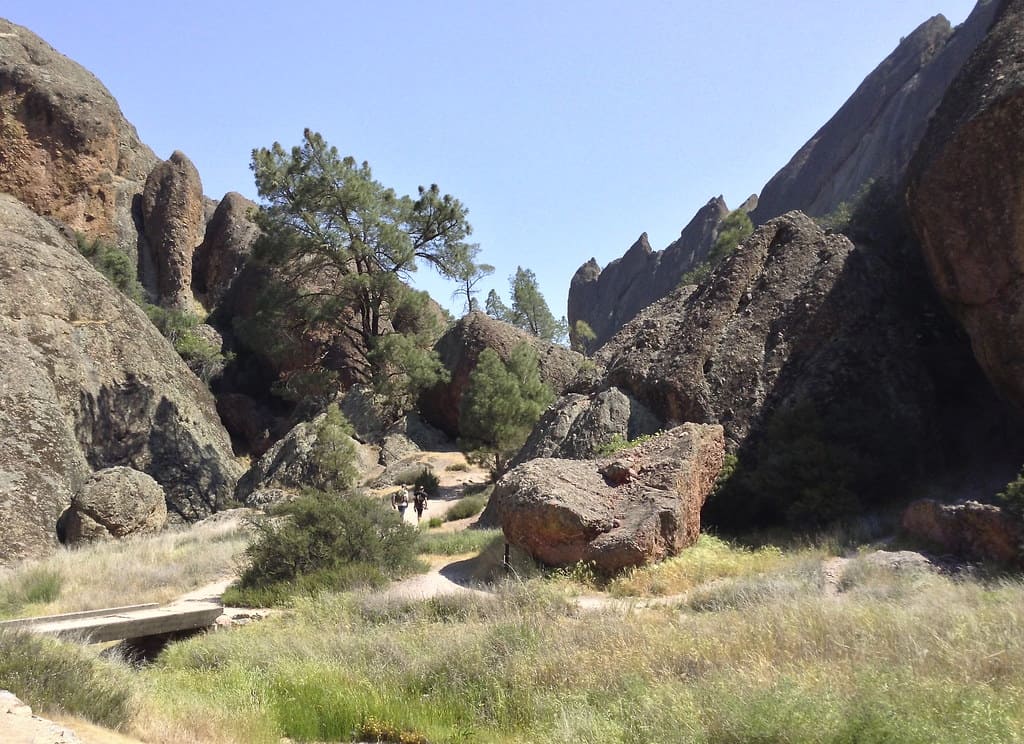
Fun fact: Talus caves aren’t formed underground/ They are formed by giant boulders that fell into narrow canyons, creating cool, shady tunnels perfect for bat colonies and adventurous hikers.
Boyden Cavern in Kings Canyon
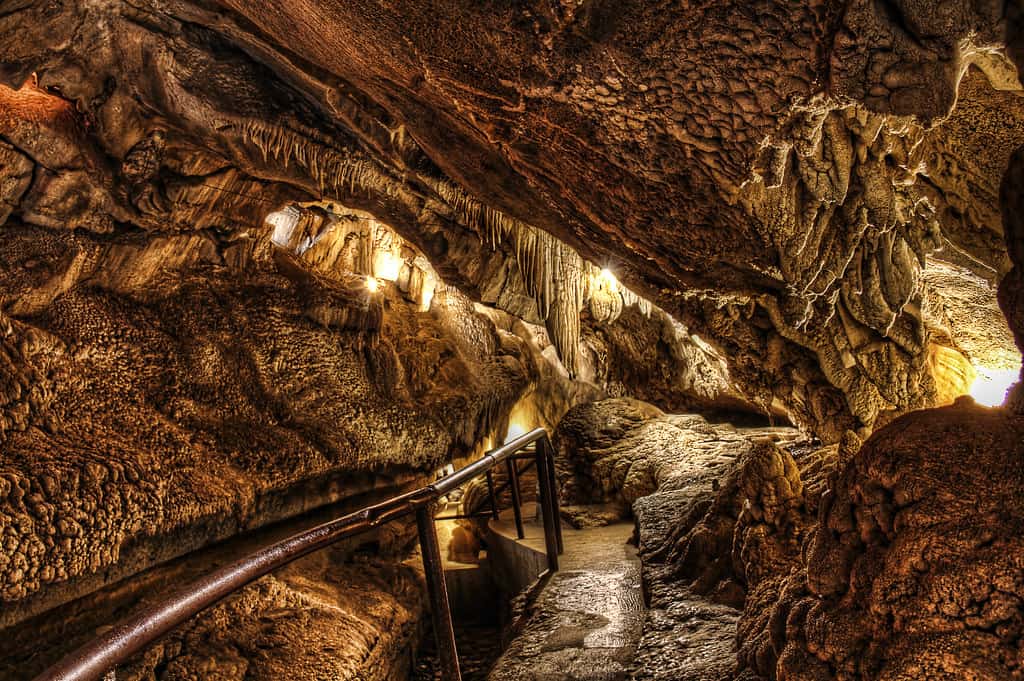
What makes it unique: A marble cave tucked beneath towering granite cliffs in Kings Canyon’s scenic marble gorge.
Visiting tips:
- Location: Just off Highway 180 in Giant Sequoia National Monument (not inside Kings Canyon NP, but nearby)
- Seasonal access: Open late April–mid-November (weather dependent)
- Tour info: 45–50 minute guided tours include formations like stalactites, flowstone, and curtains
- Physical effort: A short but steep walk leads to the entrance; inside, expect some stairs and tight turns, but no crawling
- Consistent temperature: 55°F year-round — bring a light jacket
There is a wonderful cavern to visit alongside Highyway 180 as it winds its way down into Kings Canyon. Boyden Cavern is technically in both Giant Sequoia National Monument and Sequoia National Forest and it should definitely be on you vacation itinerary when you are visiting Kings Canyon.
Fun fact: The cavern lies alongside the Kings River in a dramatic gorge carved through marble, offering one of the few roadside cave experiences in the Sierra Nevada.
Crystal Cave in Sequoia National Park
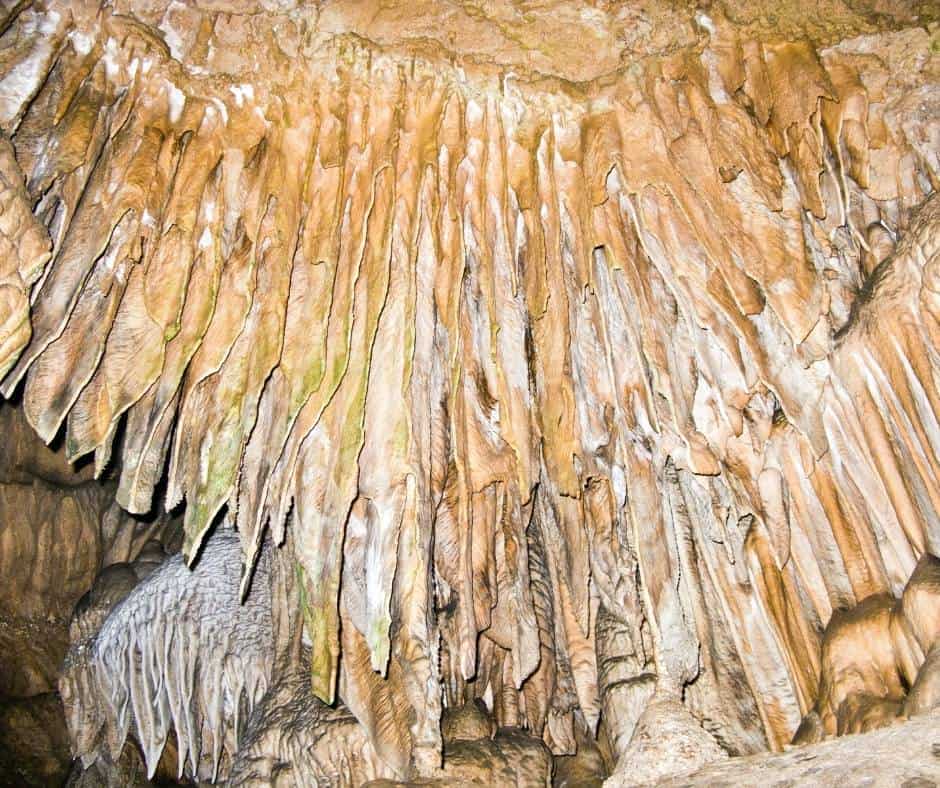
What makes it unique: A marble cave filled with draperies, soda straws, and flowstone in California’s second national park.
Visiting tips:
- Located in Sequoia National Park — advance online reservations required
- Steep ½-mile walk from parking area to the cave entrance
- Tour options: Family Tour, Flashlight Discovery Tour, and Wild Cave Tour for ages 10+
- Cave temp: Always 50°F — dress warmly
- Closed in winter: Typically open from late May through September
Kings Canyon’s sister park, Sequoia National Park, is home to its own marble cave that is open for tours. Crystal Cave is a popular tour, and it is recommended that you purchase tickets two months in advance of your visit. Tickets must be purchased online at least 36 hours in advance.
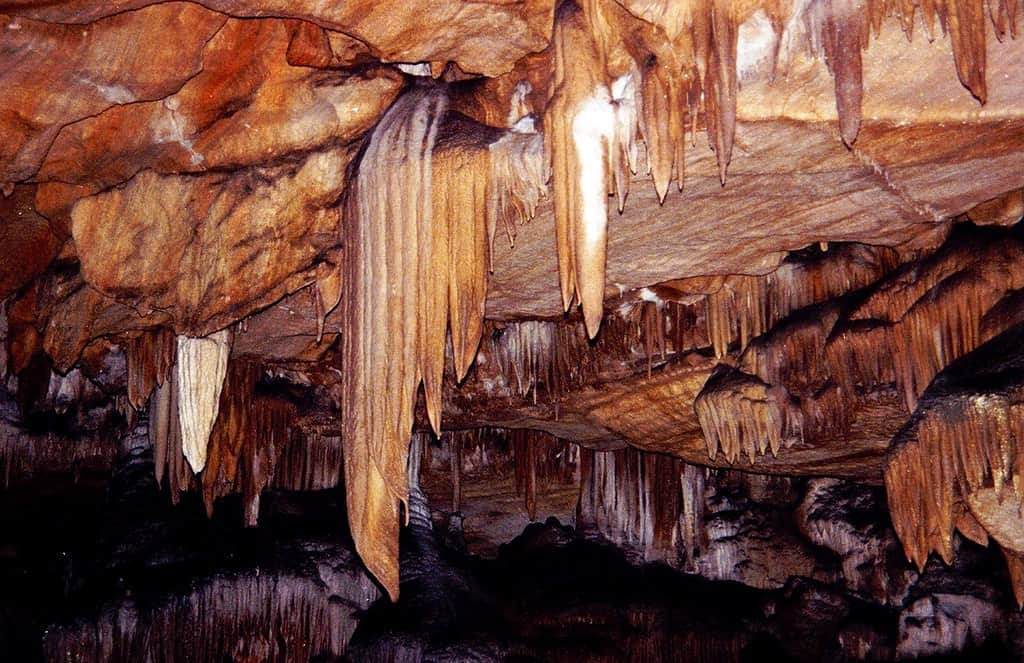
There are a few different cave tour options to choose from:
- Family Tour: A 50-minute tour that welcomes all ages.
- Thirteen and Older Tour: Like the 50-minute Family Tour but designed for those 13 years and older.
- Discovery Tour: 90 minute tour for 13 and up. It is a flashlight tour that is designed to go more in depth than the regular tour.
- Family Wild Cave Tour: For families with kids as young as 10, this is a tour where you get to put on helmets, kneepads, and headlamps to get dirty and explore more of the cave. You will be climbing over rocks and through tight spaces.
- Wild Cave Tour: Still want more? Take a 4.5-hour journey into the cave where you will be getting dirty and experiencing portions of the cave few other due while learning about this incredible ecosystem from a cave naturalist. This tour is for ages 13 and up and you should be in good physical condition.
Sequoia National Park is also home to General Sherman, one of 75 California Landmarks you should see before you die.
Millerton Caves
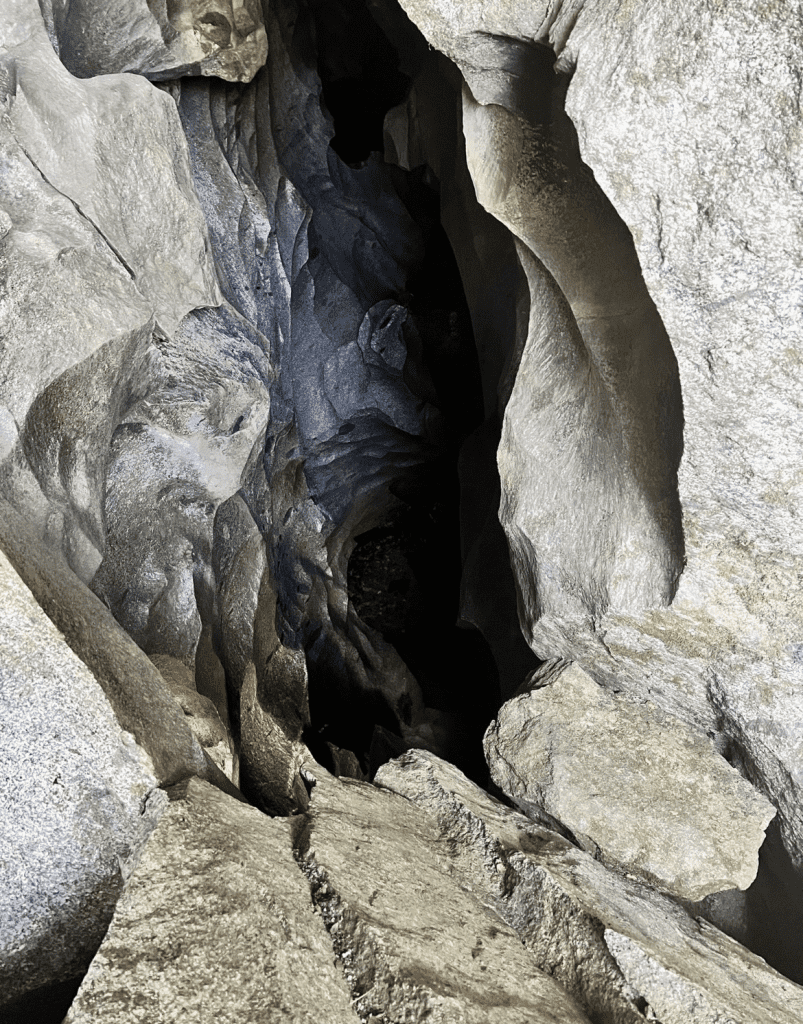
What makes it unique: Rare granite caves formed by creek erosion — a contrast to the typical limestone or lava caves in California.
Visiting tips:
- Remote and rugged: Located near Millerton Lake in the San Joaquin Gorge
- Access: Requires a 2.1-mile hike on a spur trail off the San Joaquin River Trail
- Not for beginners: No official tours — these caves are best suited for experienced spelunkers
- Gear required: Helmet, headlamp, gloves, ropes, and wetsuits (due to water flow inside)
- Caution: Avoid during the rainy season when the cave floods; granite walls can be slick
Millerton Caves are located by Millerton Lakes and are a great example of a rare, granite cave. Most people simply hike to these caves and peer in, because getting inside these caves requires some serious gear and experience.
Accessing these caves requires a 2.1-mile hike into the San Joaquin Gorge which was carved by the San Joaquin River. The trail is a spur off the river access trail which is identified by huge piles of boulders on either side of the trail.
Fun Fact: There has been discussion over the past several years about a new reservoir, called Temperance Flat, to be put into place. If this happens, the caves will be submerged under hundreds of feet of water.
Caves in Southern California
Channel Island Sea Caves
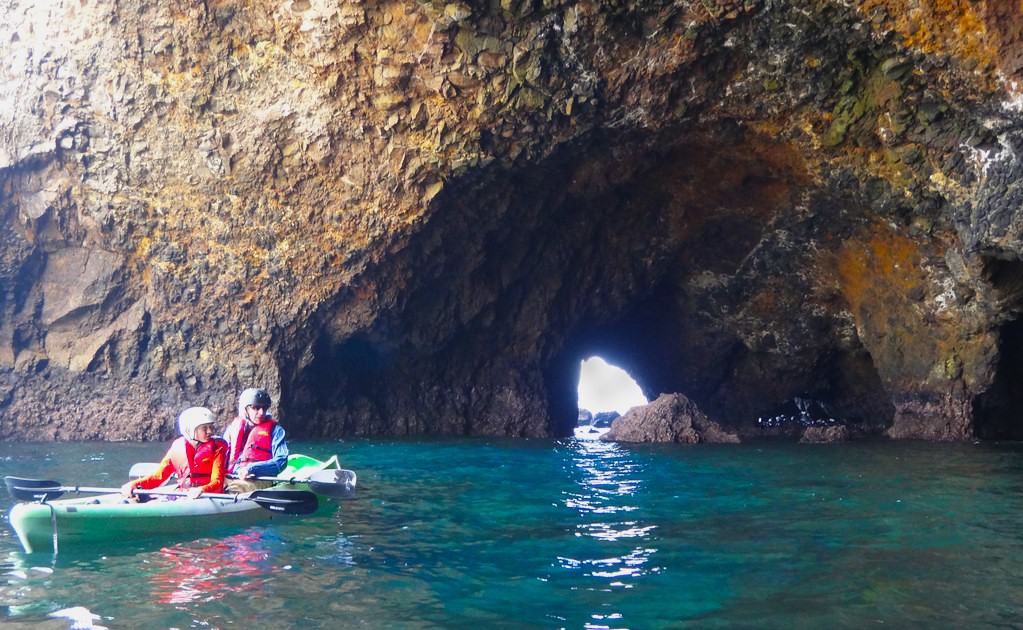
What makes it unique: Some of the largest and deepest sea caves in the world, accessible only by kayak in a remote national park setting.
Visiting tips:
- Access via ferry: Take Island Packers boat to Santa Cruz Island (Scorpion Anchorage) or Anacapa Island
- Guided tours: Book with Channel Islands Adventure Company or Channel Islands Expeditions
- Wildlife: Expect to see sea lions, harbor seals, seabirds, and maybe dolphins
- Conditions: Calm seas and good weather required for safe paddling
- Experience level: Beginners welcome; guides provide gear and instruction
- Trip length: Most kayak tours last 2–3 hours and include exploring kelp forests
In order to access these incredible caves, you will first need to book a trip out to Santa Cruz Island via Island Packers. Then you will also want to book a kayak tour so that you can paddle inside the caves.
Channel Islands Adventure Company will meet you at Scorpion Anchorage on the island and then take you on a three-hour paddling adventure. You will paddle atop pristine kelp forests and have the chance to spot wildlife as well. Of course, the real highlight is paddling through the sea caves.
Channel Islands Expeditions also offers a day trip to Anacapa Island where you can paddle thorugh this island’s sea caves and have the chance to see dolphins and sea lions.
Fun fact: Painted Cave on Santa Cruz Island is one of the largest sea caves in the world — nearly a quarter-mile long and 100 feet tall at the entrance.
Catalina made our list of our favorite Southern California weekend getaways.
Arroyo Tapiado Mud Caves
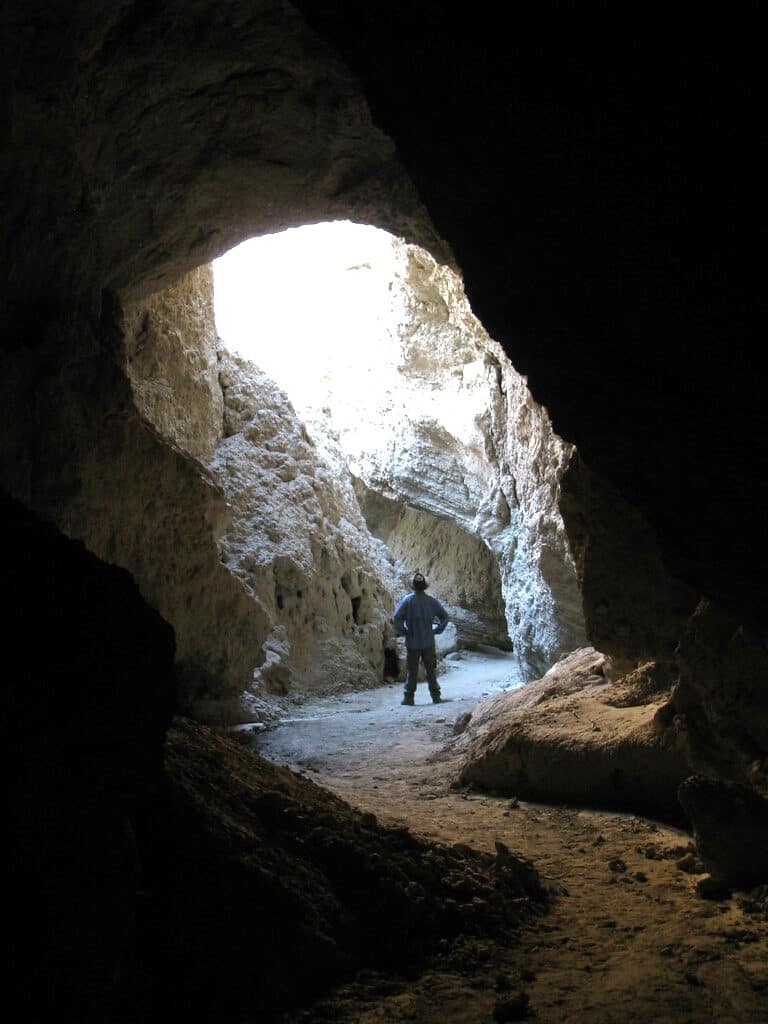
What makes it unique: One of the largest mud cave systems in the world, formed by rare geological conditions in the California desert.
Most caves are either limestone or lava rock. These caves in Anza-Borrego Desert State Park are made out of mud!
In order to reach these caves you will need a four-wheel drive vehicle since you are going to have to navigate eight miles of dirt roads. Definitely do not go if rain is in the forecast or has recently occurred. You will want to bring a light and helmet while you explore.
Visiting tips:
- Location: In Anza-Borrego Desert State Park near Ocotillo Wells
- Vehicle required: High-clearance 4WD necessary — roads are unpaved and rugged
- Exploration: 22 known caves + 9 slot canyons to explore on foot
- Gear: Bring a flashlight, helmet, long sleeves, and sturdy shoes
- Timing: Best visited in the cooler months (fall to early spring); avoid if rain is in the forecast — caves can collapse when wet
- No official trails or signage: Use a GPS and downloadable maps
Desert USA has some great information about visiting these caves.
Fun fact: The caves were formed by flash floods carving through thick layers of silt and clay over thousands of years — and continue to evolve with each storm.
Mitchell Caverns
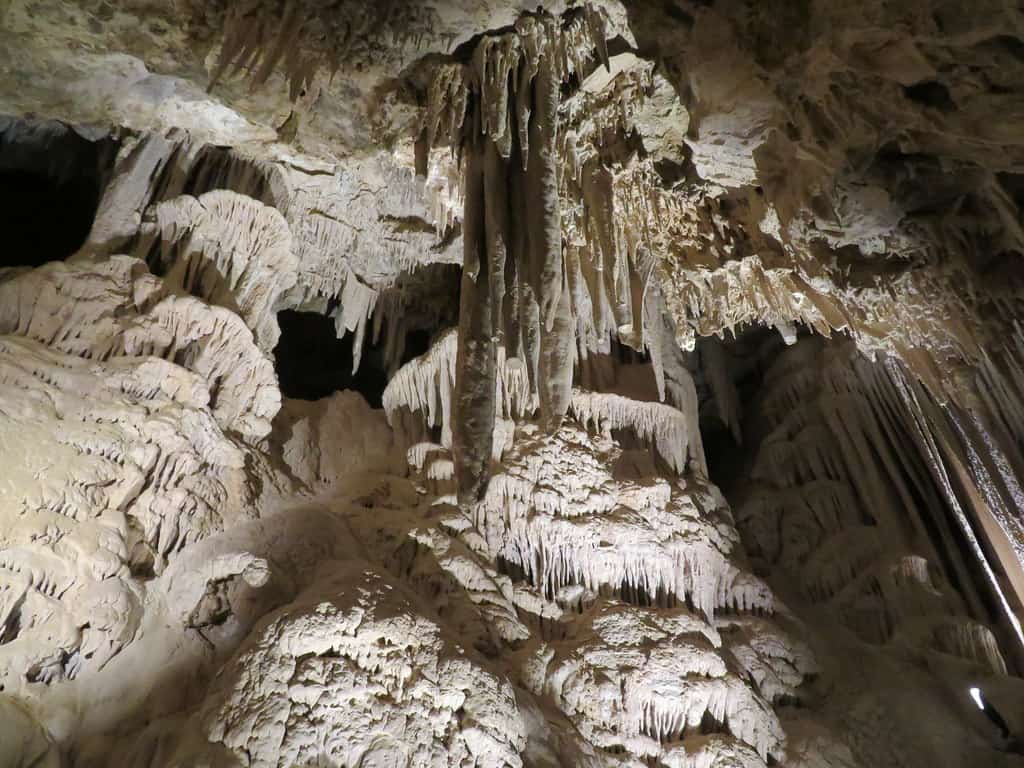
What makes it unique: The only limestone caves in the California State Park system, featuring rare formations like “coral pipes” found in only seven caves worldwide.
Visiting tips:
- Location: Providence Mountains State Recreation Area, within Mojave National Preserve
- Tours: Offered Friday–Sunday (except July & August); reservations required by phone on Mondays (760-928-2586)
- Tour details: 1.5-mile round-trip hike and a ~1-hour ranger-led tour through two cave chambers
- Cave conditions: Temperatures vary — typically in the 60s (warmer than most limestone caves)
- Facilities: Remote area; no gas or food nearby — come prepared
- Wildlife and geology: Expect to see draperies, stalactites, stalagmites, helictites, and the unique coral pipes
Mitchell Caverns are located off of Interstate 40,15 miles northwest of the Essex Road exit. The nearest major towns are Needles 56 miles away, and Barstow 115 miles away.
Tours are offered Friday through Sunday, except for in July and August. There are two tours a day for most of the year and only one tour at 10am in June and September. Tours can currently be booked by phone only on Mondays between 8am and 5pm, (760) 928-2586.
These caves were named for Jack and Ida Mitchell who ran a resort in the area from 1934 through 1954 and also led tours of the caverns.
Mitchell Caverns are known for having small clusters of knobs, called coral pipes, that are found in only seven caves in the world!
There is a really cool 3D tour of Mitchell Caverns on the state park website.
The Lava Tube in Mojave National Preserve
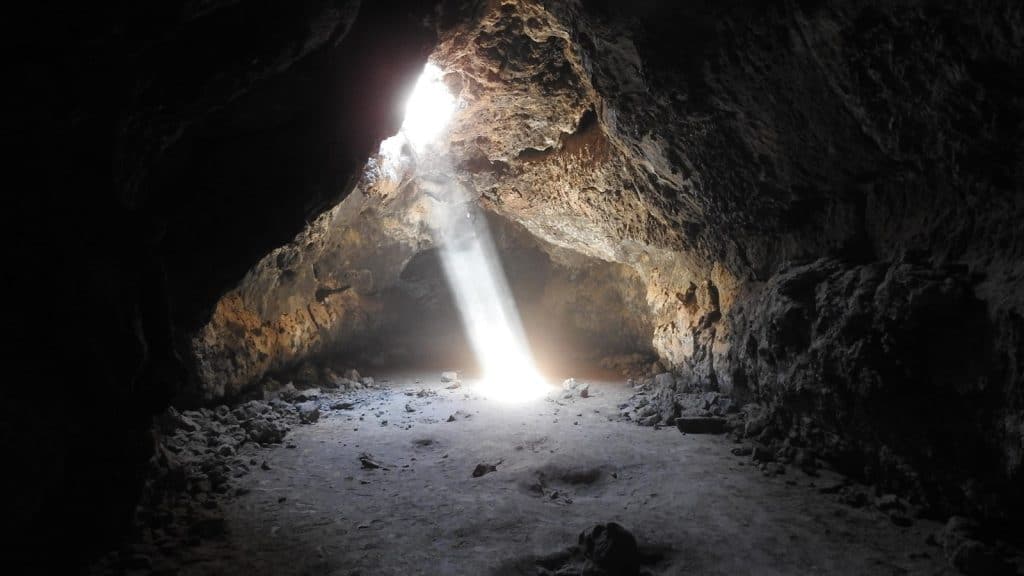
What makes it unique: This short but dramatic lava tube lights up with sunbeams in the early afternoon — a photographer’s dream.
Visiting tips:
- Location: Off Kelbaker Road in Mojave National Preserve
- Access: Rough, 5-mile dirt road — high-clearance vehicle recommended
- Hike: Short trail (0.3 miles) to the entrance with a metal ladder leading into the tube
- Best time to visit: Midday (roughly 11am–1pm) when sunlight streams through the ceiling opening
- Cave conditions: Dry and dusty; bring a flashlight or headlamp if exploring beyond the main chamber
- Facilities: No amenities nearby — carry plenty of water and check weather before visiting
Also located in Mojave National Preserve, the Lava Tube is one of the most popular destinations inside the park. It was created by molten lava 27,000 years ago. There is a beam of light that shines into the lava tube at certain times of day (usually early afternoon in the summer) making it a beautiful spot for photos.
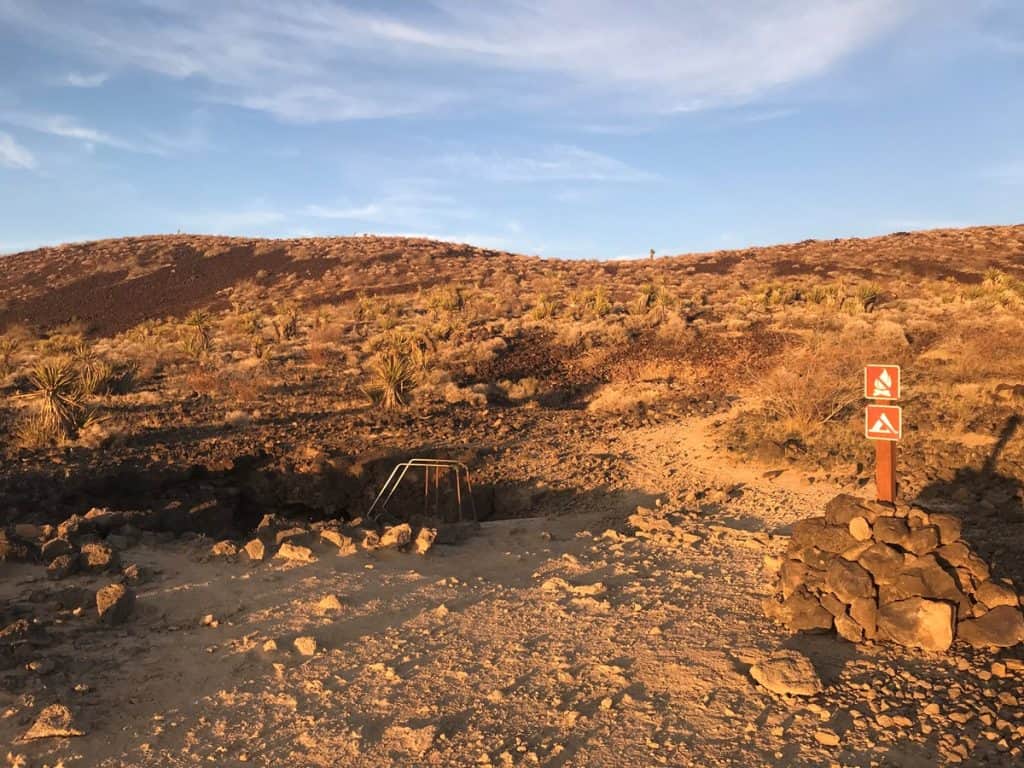
In order to reach the Lava Tube you will need a four-wheel drive vehicle with high clearance. There is a five-mile washboard road that is narrow and rough in spots. Once you arrive you will find a ladder in place to help you climb down into the cave.
Bronson Caves in Griffith Park

What makes it unique: These short, man-made caves are famous for their starring role as the Batcave in the 1960s Batman TV series.
In the heart of LA sits Griffith Park, home to the LA Zoo, Griffith Observatory, the Hollywood Sign, miles of hiking trails through urban wilderness, and the Batcave. That’s right- the original Batcave from the 1960s tv show Batman starring Adam West is in Griffith Park and you can visit it for yourself!
Visiting tips:
- Location: Griffith Park, Los Angeles — trailhead starts at Canyon Drive
- Hike: Easy ⅔-mile round-trip walk on a wide dirt road
- Cave conditions: Shallow tunnels with high ceilings — no gear needed
- Accessibility: Great for kids and casual visitors; suitable for strollers
- Parking: Free parking at the end of Canyon Drive
- Bonus: Panoramic views of the Hollywood Sign from nearby trails
Officially known as Bronson Caves, the caves were created by Union Rock company in the early 1900s who had a rock quarry in Bronson Canyon.
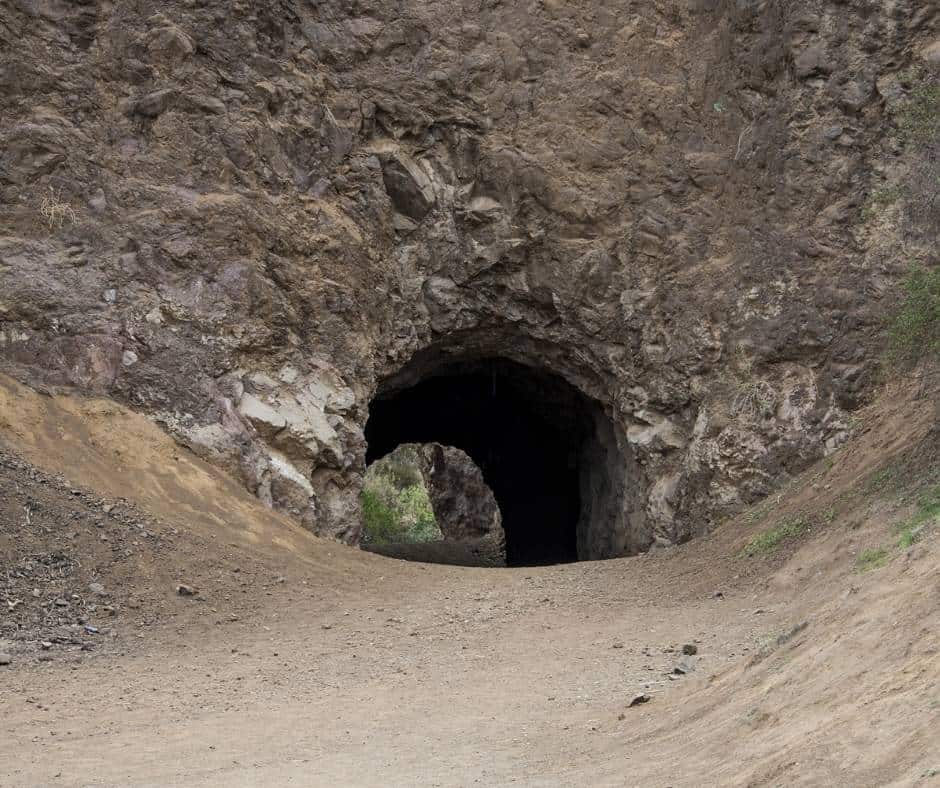
Feel free to walk around inside. You won’t need any special equipment to explore this fun, California cave filled with history. Little House on the Prairie, The Lone Ranger, Star Trek: Yoyager, and Wonder Woman are among the shows that have used Bronson Caves as a filming location.
Dripping Cave in Aliso Viejo
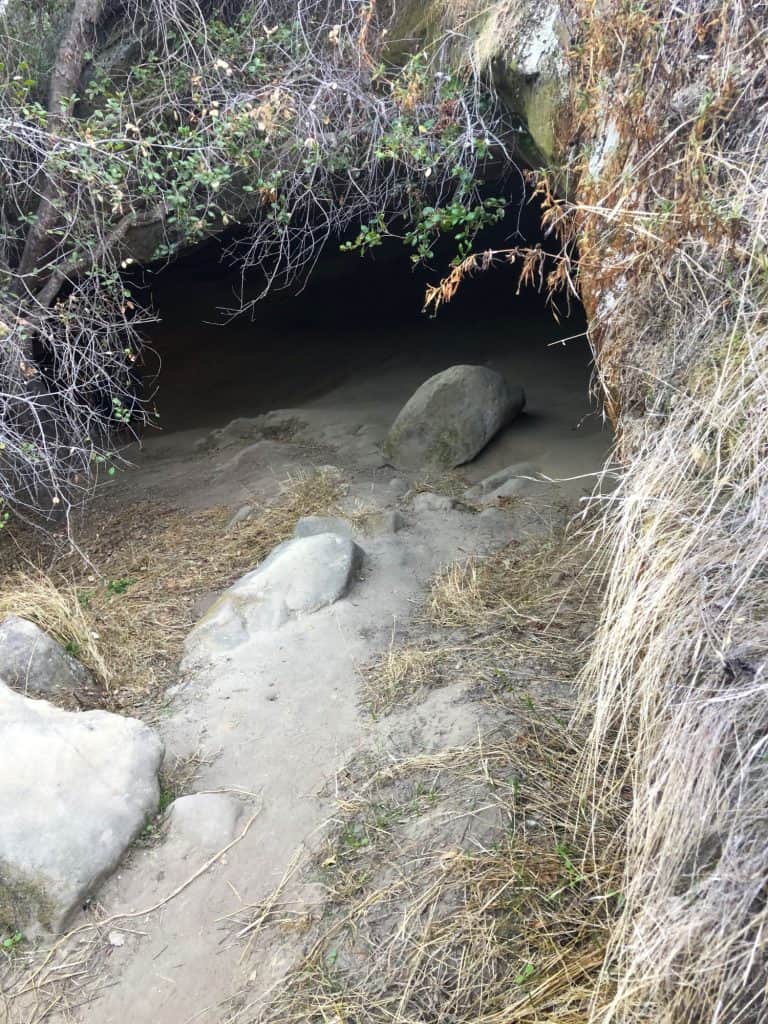
What makes it unique: Known as “Robbers Cave,” this sandstone alcove once sheltered stagecoach bandits — and it’s now a peaceful hike in suburban Orange County.
Surrounded by suburban sprawl in Orange County is Aliso and Woods Canyons Wilderness Park, a destination popular with local hikers and mountain bikers. Long before million-dollar homes surrounded these canyons, Dripping Cave had a colorful history.
Also known as “Robber’s Cave”, Dripping Cave was used as a shelter by Native Americans who once lived in the area, as well as a hide out for the Juan Flores gang who were known stagecoach robbers.
Visiting tips:
- Location: Aliso and Wood Canyons Wilderness Park
- Hike: 5-mile round trip via Aliso Creek Trail → Woods Canyon Trail → Dripping Cave Trail
- Trail type: Easy and mostly flat, with scenic canyon views and interpretive signage
- Cave conditions: Large overhang, easy to walk into — no gear or scrambling required
- Bonus: Detour to Cave Rock for smaller caves and scenic alcoves
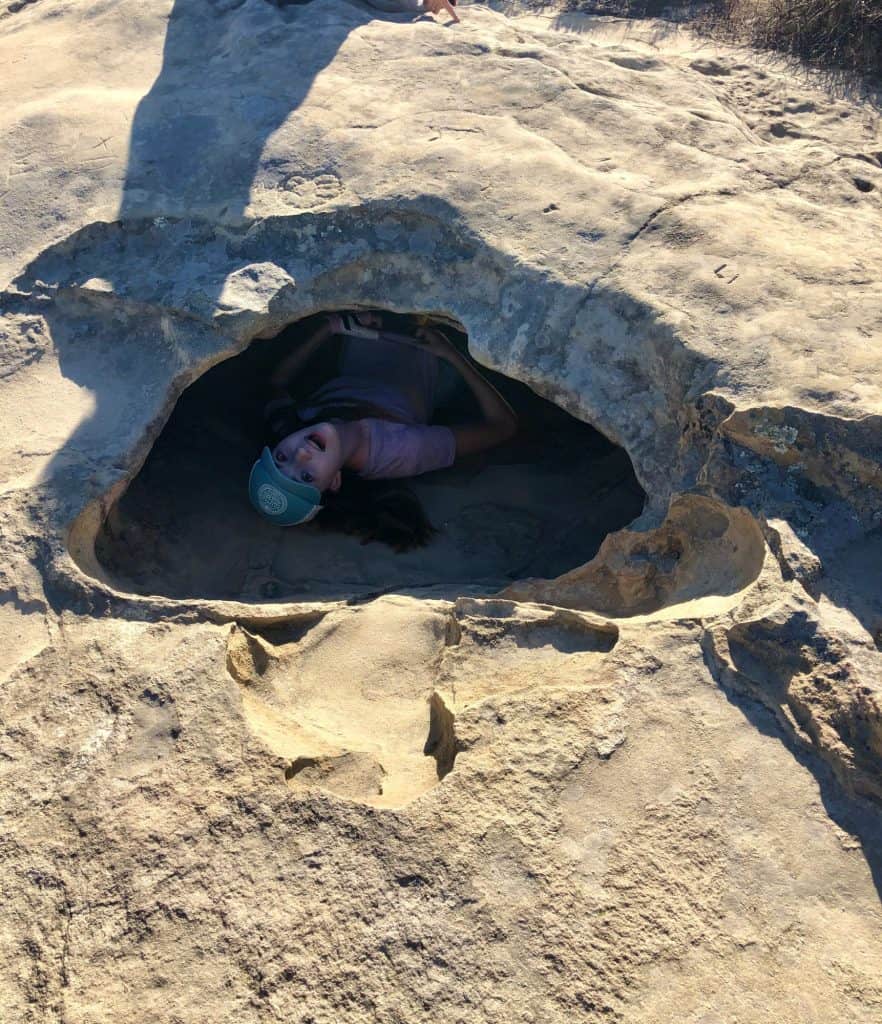
Dripping Cave itself is more like a large alcove than a cave, but it is still really fun to hike to and explore. It is easy to imagine being on the run and using it as a shelter.
Fun fact: There are dark marks on the ceiling of the cave that look like they are fire scars. In actuality, they are microscopic plant life surviving on the moisture seeping in the sandstone of cave.
Sunny Jim Cave in La Jolla and the La Jolla Sea Caves
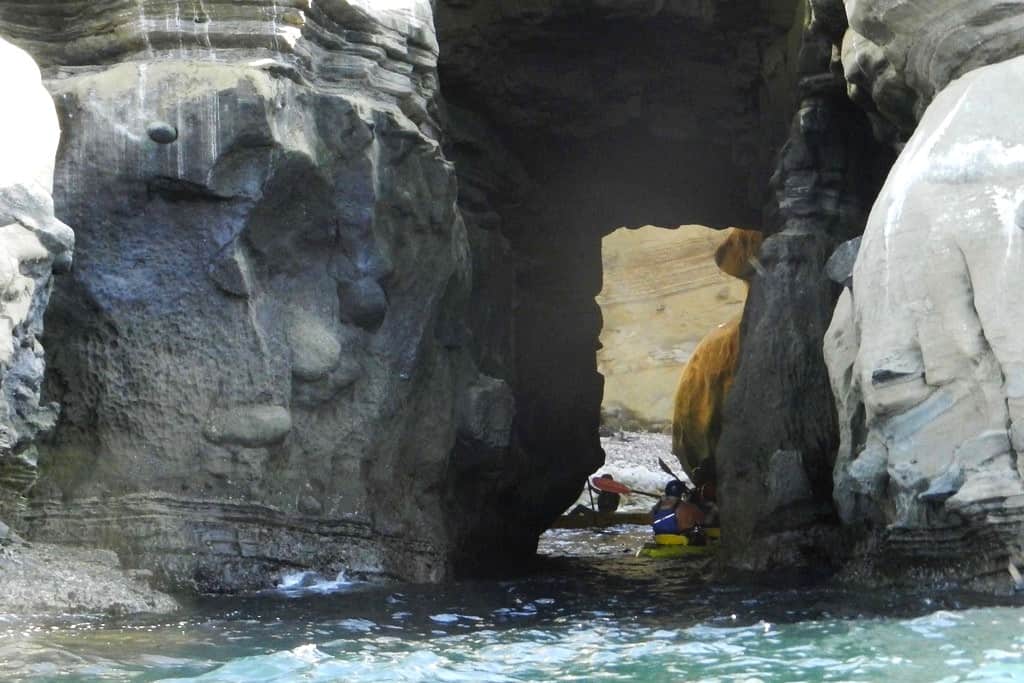
What makes it unique: A group of majestic sea caves carved into La Jolla’s sandstone cliffs — accessible only by kayak or swim when conditions allow.
Visiting tips:
- Best access: Book a guided kayak tour from La Jolla Shores
- Wildlife: Spot sea lions, leopard sharks (August–September), and cormorants
- Cave entry: Most tours allow you to enter Emerald Cave, tide permitting
- Safety first: Calm ocean days are best; always go with a guide for navigation and safety
- Family-friendly: Most outfitters welcome beginners and kids ages 5+
One of my favorite things to do in San Diego is head to La Jolla Shores and go on a kayak tour of the La Jolla Ecological Reserve and its caves. There is one cave, Emerald Cave, that you can paddle inside of as long conditions are safe.
If you time your visit correctly, you can swim with leopard sharks which use this area as their nursery. Fear not, these sharks are harmless and the experience is one you won’t forget. Prime time is August and September, when there are hundreds of sharks in the cove but there are still plenty anytime between June and October.

What makes it unique: The only sea cave in California accessible by land via a tunnel — and once a rumored bootlegging route during Prohibition.
Visiting tips:
- Location: Enter through The Cave Store in La Jolla
- Access: Pay admission to descend 145 hand-dug steps to the cave
- Cave conditions: Narrow staircase, some damp spots — wear good shoes
- Experience: Great for photos, with a framed ocean view at the cave mouth
- Bonus: Pair your visit with a kayak tour of nearby La Jolla sea caves
If kayaking isn’t your thing, you can still visit one of the La Jolla sea caves. Sunny Jim Cave is acessed via the Cave Store, a gift shop that has an entrance to the cave which you pay to access. You will have to navigate 145 steps to reach the bottom of the sea cave which is submerged in water.
Fun fact: The tunnel was dug in 1902 by a German artist who lived above it and opened it to the public in 1905 — it’s rumored to have been used to smuggle alcohol.
Cave of Munits
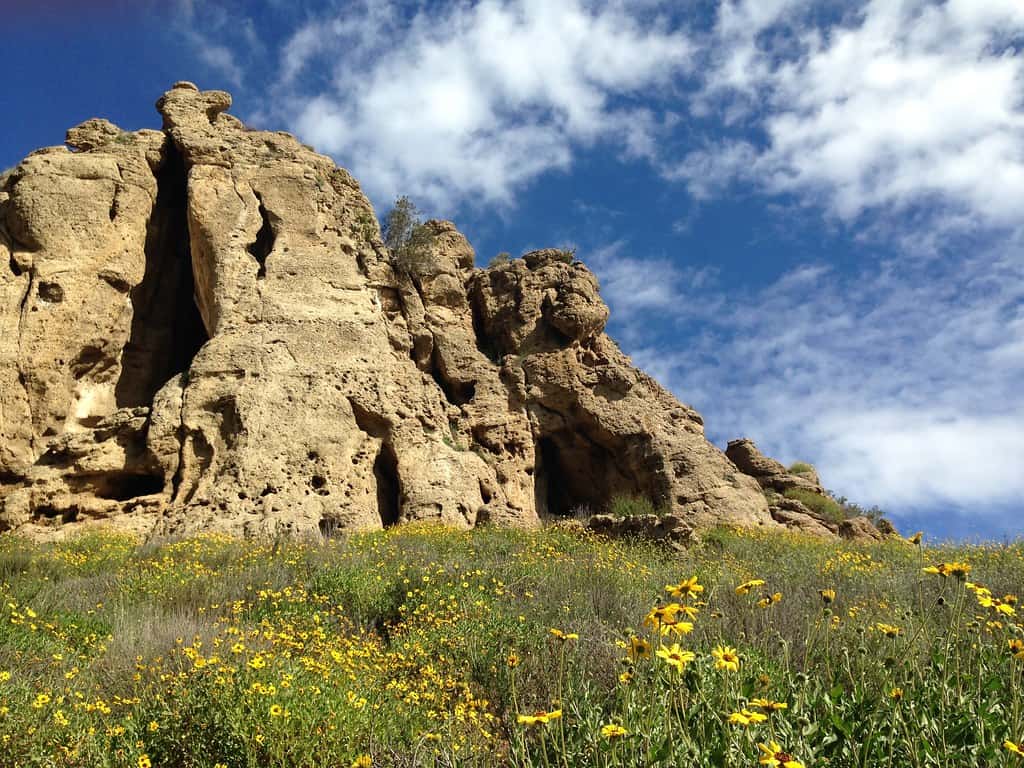
What makes it unique: A dramatic sandstone cave tied to Chumash legend, offering both cultural history and adventurous hiking in the Simi Hills.
This next cave was once an important ceremonial site for the Chumash Indians. The Cave of Munits is located in the Simi Hills near Castle Peak, and was said to once be the home of a Chumash shaman who was killed for murdering the son of a chief.
Visiting tips:
- Location: Inside Upper Las Virgenes Canyon Open Space Preserve (Ahmanson Ranch), in West Hills
- Hike details: 0.8-mile one-way hike from El Escorpión Park; extend to a 2.1-mile loop with Castle Peak summit
- Climb required: Light scrambling is needed to access the cave interior — wear good shoes
- Inside the cave: A spacious main chamber with high ceilings and side passages to explore
- Best season: Visit in winter or spring for green hillsides and cooler temps
It is an scenic, 0.8-mile hike from El Escorpion Park to the entrance of the Cave of Munits. Visit during the late winter or spring to be surrounded by gorgeous green hillsides.
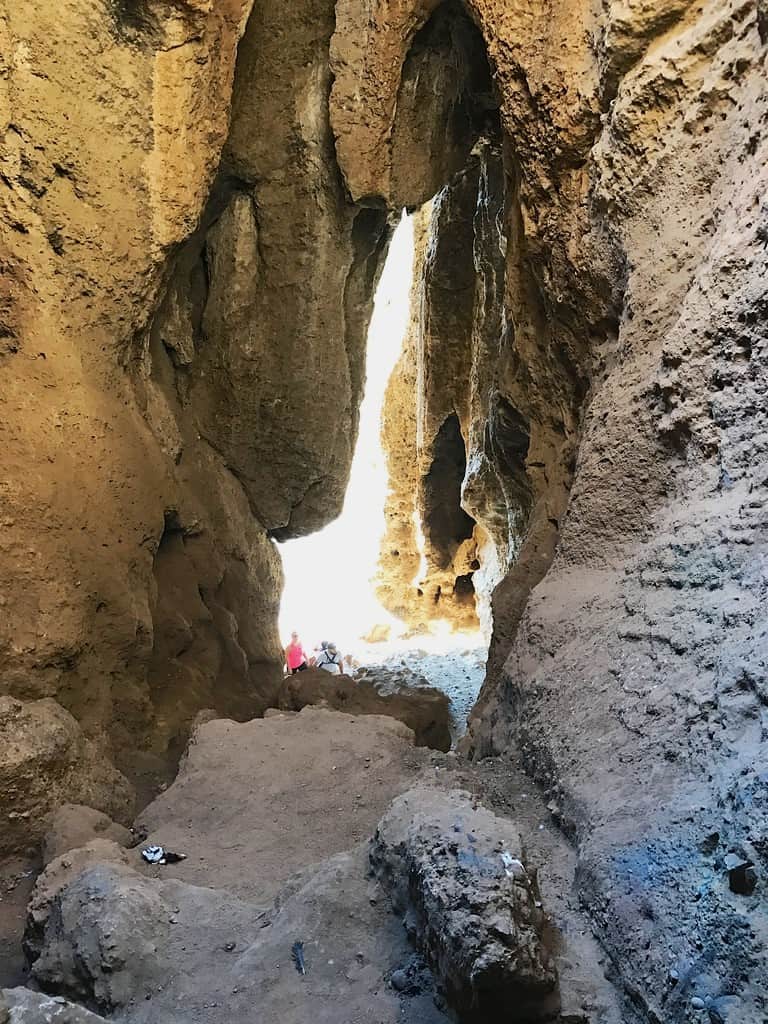
Climbing inside the cave is a bit of a scramble, but it is worth your efforts. The inside of the cave is quite large, and there are several little side caves to explore.
Many people extend their hike to climb to the top of Castle Peak, making for a 2.1-mile loop in all.
Grant Sea Caves at Leo Carrillo State Park

What makes it unique: These photogenic sea caves are carved into the rocky headlands of Malibu and are easily accessible during low tide.
Malibu is well known for being home to the rich and famous, but it is also home to a couple sets of impressive sea caves.
The first set are at Leo Carrillo State Park. This beach is a destination for surfing, camping, and tide pooling. And, of course, there are the caves.
Visiting tips:
- Location: Leo Carrillo State Park, just off the Pacific Coast Highway north of Malibu
- Best time to visit: Low tide is essential — always check tide charts before exploring
- How to access: Walk south from North Beach toward the rocky point dividing North and South Beaches
- Conditions: Be cautious of slippery rocks and incoming tides; explore only when safe
- Extra fun: Great for photos, tidepooling, and watching surfers from the beach
Fun fact: Leo Carrillo, the actor and preservationist, helped protect this stretch of coastline, now a favorite for beachgoers and cave explorers alike.
El Matador Beach Sea Caves in Malibu
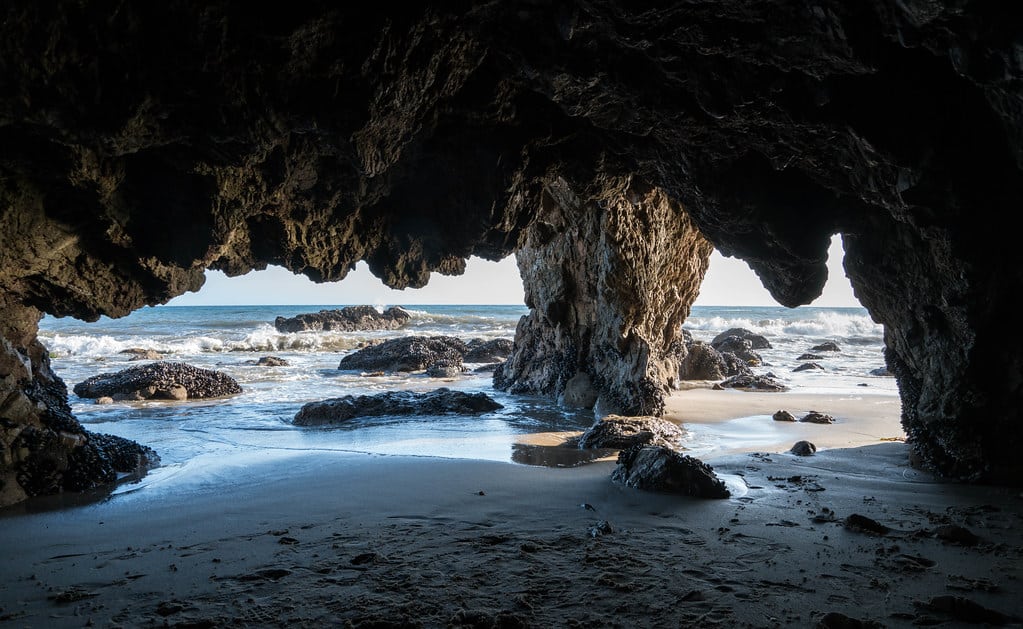
What makes it unique: This beach boasts the most dramatic sea caves and rock arches in Southern California — perfect for adventurers and photographers alike.
Visiting tips:
- Location: Off Pacific Coast Highway in Malibu, about 10 miles northwest of Santa Monica
- Access: A steep staircase leads from the bluff-top parking lot down to the beach
- Best time to explore: Low tide — the caves and arches are only accessible when the tide is out
- Parking: Limited to about 20 spaces — arrive early or on weekdays to improve your chances
- Activities: Explore the caves, snap epic coastal photos, enjoy a picnic, or catch a sunset
El Matador Beach is south of Leo Carrillo and home to more rock arches and sea caves than any other beach in Southern Caifornia.
Fun fact: El Matador is often used in photo shoots and films thanks to its natural beauty, towering cliffs, and unique rock formations.
Little Corona Del Mar Beach Sea Cave

What makes it unique: A hidden gem in Orange County, this beach features small sea caves and tide pools tucked beneath coastal bluffs — perfect for families and casual explorers.
Visiting tips:
- Location: Just north of Corona del Mar State Beach in Newport Beach
- Access: Walk down a steep, paved path from a residential neighborhood; no stairs required
- Best time to visit: Low tide to safely explore tide pools and the small caves
- What to bring: Water shoes or sandals, and a camera for the scenic arch rock just offshore
- Wildlife: Look for anemones, sea urchins, hermit crabs, and sometimes even octopuses in the tide pools
Little Corona del Mar Beach is one of the best beaches in Orange County to explore during low tide. There are several great tide pools filled with sea anemones, urchins, crabs, and the occassional octopus.
On the south end of the beach around the bend you will discover several small caves in the bluff. There is also a cool arch rock in the water you won’t want to miss. The caves are small but they are perfect for playing “pirate” in.
Thousands Steps Beach Sea Cave in Laguna Beach

What makes it unique: This Laguna Beach favorite offers dramatic sea caves, tide pools, and striking rock formations — all accessible at low tide.
Visiting tips:
- Location: Off 9th Avenue and Pacific Coast Highway in South Laguna
- Access: Descend 223 concrete steps (not really 1,000!) to reach the sand
- Tide awareness: Visit only at low tide to access the cave and avoid being trapped by the rising ocean
- What to bring: Grippy footwear, flashlight (for deeper cave nooks), and plenty of water — there are no services below
- Explore: Head south along the beach to find the sea cave and tidepools; look for starfish and sea anemones in the rocky pockets
Laguna Beach is home to the final sea cave on our list, located at Thousand Steps Beach. You won’t have to climb down 1,000 stairs to reach this beach but you will have to make it down 223 of them.
Visit this beach at low tide, head south, and you will be rewarded with several large tidepools and a sea cave.

